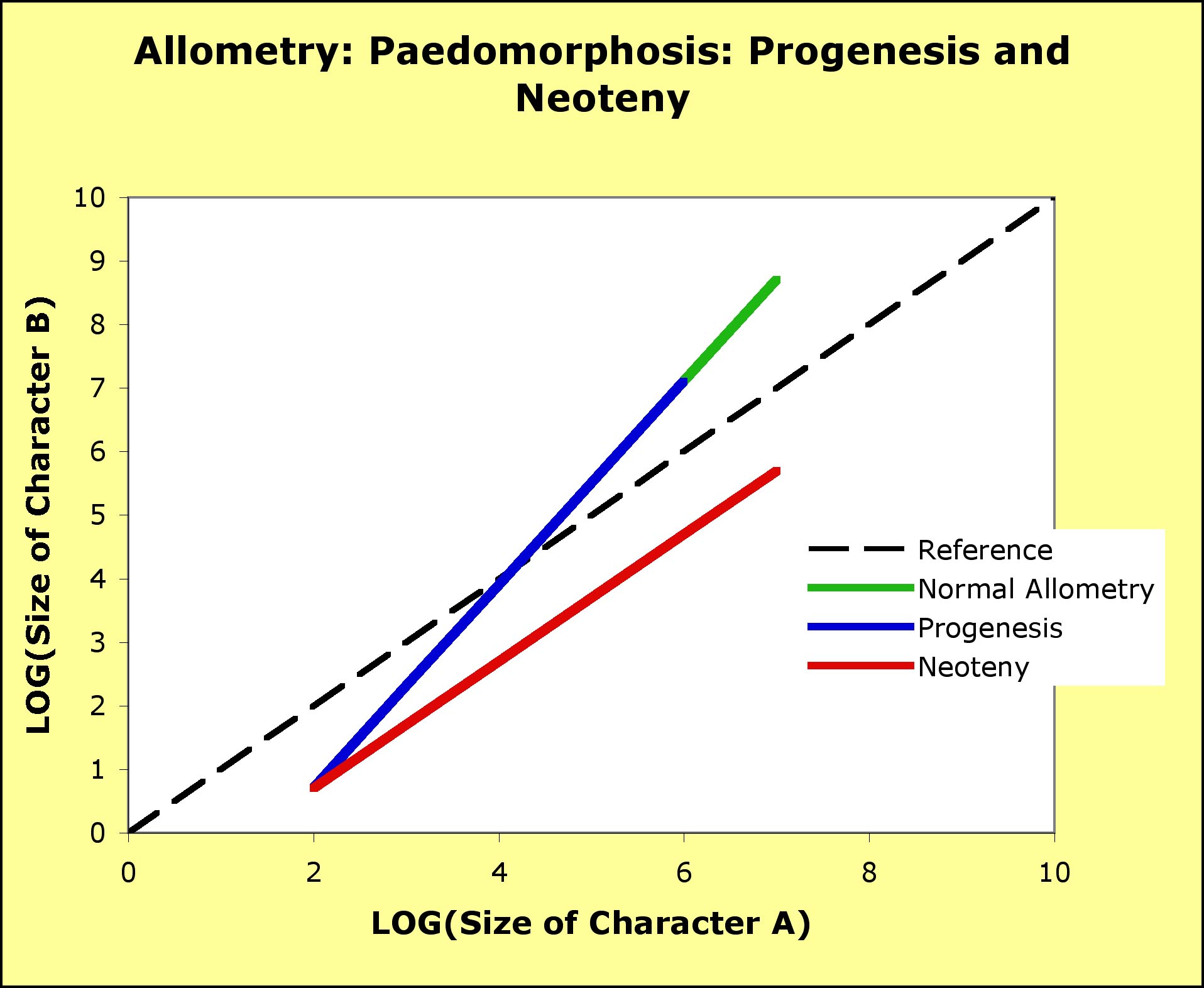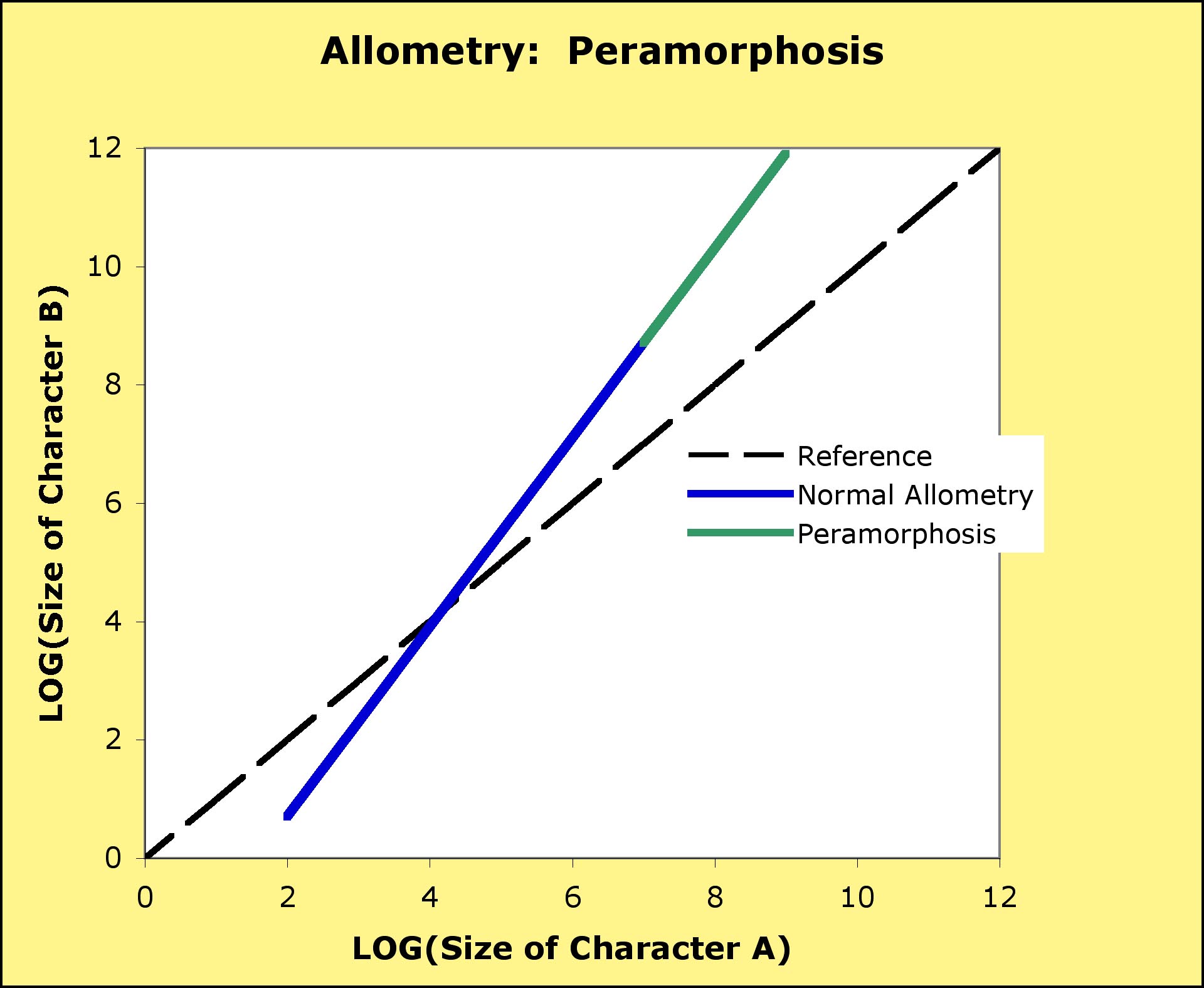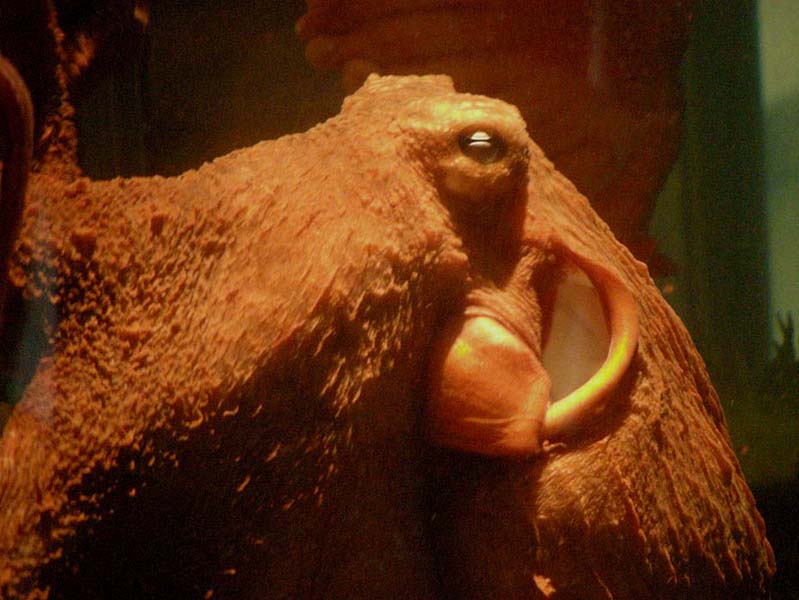|
BIOL
4160
Evolution
Phil Ganter
301 Harned Hall
963-5782 |
The Giant
Pacific Octopus (Enteroctopus dofleini) grows up to 150
lbs (averages 40 lbs), has a tentacle-span of 15 feet, lives
only
3 to 5 years, and a female can lay over 100,000 eggs. Nnotice
it's pupil is not round. The cephalopod camera eye may represent
a more rational design than our vertebrate camera eye. We
may be an example of suboptimal design (see below). |
Some Patterns in Evolution
Email me
Link
to a list of Specific
Objectives for lectures
Back
to:
Evolution and Classification
Branching versus Hierarchical classification
- Hierarchy is a classification
scheme in which there is a "vertical" component, an idea of
higher and lower, usually an outcome of inclusiveness in the sense that
higher group in the hierarchy is composed of one or more groups from
the next lower level
- Domain-Kingdom-Phylum-Class-Order-Family-Genus-Species
system is a hierarchical system
- This is an artificial system because
it requires the same number of levels to describe each organism
but that may not be an accurate reflection of their evolutionary
history
- The inadequacy of this approach becomes
obvious when you compare two species
- Drosophila mauritiana is
a member of the large, polyphyletic genus Drosophila (>1450
species) that occurs on the island of Mauritius in the Indian
Ocean. Its closest relative is D. simulans,
from which it diverged about 250,000 MYA (McDermott SR, Kliman
RM 2008 Estimation of Isolation Times of the
Island Species in the Drosophila simulans Complex
from Multilocus DNA Sequence Data. PLoS ONE 3(6):
e2442. doi:10.1371/journal.pone.0002442)
- According to Uniprot (a
large database of protein sequences from all
organisms), the classification of D. mauritiana is
as follows: Arthropod (Phylum)-Mandible
(Class)-Dicondylia-Pterygota-Neoptera-Endopterygota-Diptera
(Order)-Brachycera-Muscomorpha-Eremoneura-Cyclorrhapha-Schizophora-Acalyptratae-Ephydroidea-Drosophilidae
(Family)- Drosophilinae-Drosophilini-Drosophilina-Drosophiliti-Drosophila
(Genus)-Sophophora-melanogaster group-melanogaster
subgroup
- Gingko biloba's closest
living relative, probably a cycad, is a member of a different
phylum, according to the USDA's hierarchical classification
of plants, and from which it diverged at least 270 MYA (during
the Permian - divergence time over a billion times longer
than for D. mauritiana and its closest relative)
- In order to adhere to the
biological taxonomic hierarchy, we need to make a phylum,
class, order, family and genus with only one member
(Ginkgophyta-Ginkgoopsida-Ginkgoales-Ginkgoaceae-Ginkgo)
to classify this one species
- D. mauritiana classification
involves adding many additional levels not seen in the classification
of Ginkgo biloba
- D. mauritana has
26 levels (3 below the level of the genus) and G.
biloba has 5 levels (and it's the only member
of its group on any level)
- Thus, one hierarchy does not fit
all organisms
- A Branching system is one in which earlier
groups divide to produce new groups and so they reflect time and do not
necessitate have a hierarchical structure
- The metaphor of a tree as a branching
system is apt here (the trunk of the tree precedes -- or is more
primitive than -- any branches that originate from it)
- Branching classifications can be natural
if the branches reflect the true evolutionary history
- We are in a transition period
between the common use of hierarchical classification and
a more natural branching classification of life
- Go to the "TREE OF LIFE" [http://www.tolweb.org]
website to see a branching history of life
- Phylogeneticists do not use hierarchical systems
- Phylogenetic change can occur as a branching
event (Cladeogenesis)
or as change along a branch without a division (Anagenesis)
- A Clade is
an ancestor and all of its descendent lineages
- Phylogenies are presented as Tree
Diagrams
- Cladograms -
show only the branching (can be Rooted or Unrooted)
- Phenograms - show the branching
and the length of the branch indicates the distance
between a taxon and its most recent ancestor (rooted
trees) or between taxa (unrooted trees)
- Will we do away with the hierarchical
classification schemes?
- As of now, the answer is no because:
- the professional taxonomy
societies have not abandoned hierarchies
- databases (protein, nucleotide
sequence, etc.) need the hierarchical system because
they need to organize their data just like librarians
need to organize theirs and the available computer
algorithms for such tasks use hierarchies
- Links to examples of:
- A hierarchial system
- A cladistic (branching) system
Evidence for Evolution
through Cladogenesis and Natural Selection
The evidence for evolution is to be found in
the geological record
- Darwin argued that evolution occurred as a branching
process (cladogenesis), primarily through the mechanism of natural selection
- Within the scientific community, there are no
currently debated theories of evolution that do not involve cladogenesis
but other explanations were part of the scientific debate when Darwin published
his book and some have persisted outside of science up to the present
- The most common alternative then and now was
special creation for all species (and higher taxa)
- Note that branching is a separate hypothesis
from natural selection as the most influential mechanism of evolution and
we do currently debate the relative importance of natural selection and
other mechanisms of evolutionary change.
Evidence for Cladogenesis and Natural Selection
- Hierarchical organization
- I differ with the text
in my definition of hierarchy, and so I differ with his citation of hierarchical
classification
as evidence
for cladogenesis
- To me, hierarchies must have levels,
not just groups formed from pre-existing groups
- Hierarchical classification's levels makes
it possible to designate classes, orders, and families,
while strictly branching classifications have no consistency
in their groupings and the levels of taxonomy have no relevance
- Evidence from Development
- Homology
- Homologous structures are those that are linked
by development, even though their final forms may be very dissimilar
- The same patch of cells that become a jaw bone
in fish become an inner ear bone in mammals
- Homology is why we find five digits in the wing
of a bat, our hands, and a whale's flipper - all share similar developmental
origins but all follow different developmental trajectories
- Homology is evidence of cladogenesis because
it can be explained through the independent modification of development
once a branching event has occurred
- Cladogenesis predicts homologous structures,
whereas other patterns of evolution do not predict homology
(although they may not be inconsistent with it)
- Organisms that have lost characters (the
text mentions the teeth in anteaters and an aquatic part of the life cycle
in some amphibians), may still go through part of the development of the
lost characters
- Once again, this is predicted by cladogenesis
but not by other means of evolution
- Vestigial characters
- Sightless eyes in cave dwellers (useful if not
in caves), our ear muscles (useful if ears are mounted atop the head)
- Cladogenesis
predicts this one as well but no alternative does
- Analogies
- When two different lineages develop similar structures
with equivalent functions, the power of natural selection is evident
- Suboptimal Design
- Natural selection selects the best from the available
alternatives, no optimality is guaranteed unless the optimal alternative
is present, so natural selection predicts the possibility of suboptimal
design
- No good engineer would design humans so that
they could choke on their food
- Why are our eyes designed so poorly that we have
a blind spot - cuttlefish have a camera eye and no blind spot (we was robbed!)
- Distribution of species
- Related species often have distributions that
can be predicted from the distribution of their common ancestor
- Intermediate forms
- Evolutionary history of cetaceans (whales and
relatives)
- Cladogenesis predicts intermediates but no other
means of evolution
Evolutionary Trends and
Systematics
Patterns in Development
- Phenotypic evolution depends on development of
the organism but this obvious truism has some subtle and interesting outcomes
- Modular development
- Many animals and plants are modular
in that the overall body is composed of a series of modules
that are basically all the same
- In old fashioned zoology,
this phenomenon is known as metamerism and
the modules are called metameres (the
book does not use these terms)
- Although the modules start out similar,
many modules have independent developmental pathways so that,
when fully grown, they acquire specialized functions and are
much modified in the adult organism
- Due to the extensive modification
modules may undergo, modules are often most easily seen
early in development
- This process of independent developmental
fates for modules is called Individualization (the
term does not refer to each organism developing into an individual
but each module having an individual developmental fate)
- This means of building a complex
organism (similar to building a complex molecule, n'est-ce
pas?) allows for small changes in the developmental pathways
of individual modules to greatly alter the overall phenotype
of an organism
Heterochrony
- Phenotypic change can be effected by heterochrony:
alterations to the timing of developmental events
- One example is when the development of
the reproductive system is altered relative to the rest of the organism
so that the organism still has many juvenile features when it attains
maturity, a process called Paedomorphosis (remember,
maturity in biology is when an organism becomes reproductively competent)
- The opposite example occurs when the development
of the reproductive system is altered relative to some other part
of the organism such that the non-reproductive feature of the organism
develops past where
it
would otherwise be when the reproductive system matures, a process
called Peramorphosis
Allometry
- Allometric growth is produced by different parts
of the body growing at different rates (our heads grow more slowly than
our legs, for instance)
- Many evolutionary changes to phenotypes are
the result of alterations of the growth rate of individual body parts
- We often detect allometry by relating
the size of two body parts in several related species and looking
for a line or curve that passes through the points (each species
provides a point)
- Many relationships are not linear but
are described well by using a power curve (often called the allometric
function):
- If y is the size of one body part
and x is the size of another, then the allometric function
is
y
= bxa
- This equation is a curve
but it can be linearized (turned into a linear equation of the form
y = mx + b) by taking the log of each side (linear equations are easier
to analyze)
log(y)
= log(b) + a(log(x)) - a is
the slope and log(b) is the y-intercept
- If there is no allometry, then the growth
of the body parts relative to one another is the same in each species
(even though the overall size may differ) and the linearized allometric
relationship has a slope of 1
- Departures from this line are evidence
of allometric growth
- If one structure is doubled in size,
the other is also doubled (allometry occurs when one structure
is doubled but the other is changes by a ratio greater than or
less than, but not equal to, 2)
- Allometric change can involve changes in the rate
of development, the duration of development,
or the time
of initiation of development of particular body parts or systems
- Because growth is not linear,
these changes can produce a great range of possible phenotypes
from a very similar set of genes
- For instance, Paedomorphosis (first
graph below) can result from the slowing of the body's
development relative to the reproductive system (Neoteny)
or
by halting growth early (Progenesis)
- Neoteny is
the reduction of the growth rate of a character
- Progenesis results
in a change in the ratio of sizes for the two
structures
- Peramorphosis may
be the result of allowing growth to proceed for a
longer
period (second graph below)
- Those structures growing
fastest or longest will become very much larger
than other, more slowly growing, structures


Heterotopy
- This is the repositioning of body parts or
a change in the place in which a gene is expressed
- Many genes are expressed only in certain places
(the gene for crystallin, the protein found in the eye's lens, has undergone
heterotrophy as the gene products have gained new functions in the body)
Adaptive
Radiation
- This topic will be treated in several places
but it refers to a burst of speciation within a lineage when that lineage
colonizes a new habitat
- Often seen on islands (land snails in the South
Pacific) and in deep lakes ( Gammarid amphipods in Lake Biakal)
Genes and Genomes
Student Presentation
Last updated January 28, 2010


